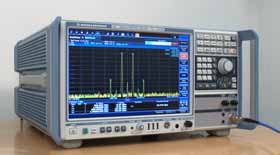Real Time FFT Spectrum Analyzer
There is an increasing amount of talk about real time spectrum analyzers and what they can do.
Spectrum Analyzer Tutorial Includes:
What is a spectrum analyzer
Spectrum analyzer types and technologies
Superheterodyne / sweep spectrum analyzer
FFT spectrum analyzer
Realtime spectrum analyzer
USB spectrum analyzer
Spectrum analyzer tracking generator
Specifications
Spectrum analyzer operation
Noise figure measurements
Phase noise measurements
Pulsed signal spectrum analysis
With the growing number of processor controlled radio frequency products, there is a growing need to not only capture the steady radio spectrum, but also transient effects as well. These real-time spectrum analyzers are of importance in many areas of RF testing.
It is the case that with a huge number of radio frequency signals, the signal can have transient effects - some of the RF energy can be sporadic or random in nature. It is often these transient effects that provide the insight into the issues of the signal that need to be investigated.

Using traditional superheterodyne or swept spectrum analyzers, capturing transient effects is very difficult. Many of the transient signal effects go totally unnoticed and they can certainly not be investigated.
With many signal formats using techniques like frequency hopping, and other signals using pulsed techniques, or spread spectrum, it is essential that the whole spectrum of interest is continually monitored sot hat the required events and effects can be captured however short they may be.
It is for applications like these that real time spectrum analysers are the essential tool - superheterodyne spectrum analysers or even the basic digital FFT spectrum analysers cannot be guaranteed to capture the transient effects.
Realtime spectrum analyser basics: what is an RTSA
The key concept that is required to implement a real time spectrum analyzer is the capability to be able to continuously monitor the spectrum.
Non-real time spectrum analysers take a series of samples which are then processed and displayed, or passed to memory for further analysis.

It can be seen that between the different samples, that it is possible to miss various transient events.
Superheterodyne spectrum analysers provide a similar function as they take a scan which progressively moves across the scan bandwidth and then displays the spectrum. If the transient effect does not occur at the instant the scan passes the frequency of the transient, then it will not be seen.
The key to the real time spectrum analyzer is that it takes successive overlapping FFT samples. and in this way it provides a 100% probability of intercept, POI for the transient signal.

By analysing the waveform in this way, transient effects that may not be visible on other forms of spectrum analyser can be captured and highlighted.
Real time spectrum analyzer characteristics
There are a number of characteristics of realtime spectrum analyzers:
- These test instruments are based around an FFT - Fast Fourier Transform spectrum analyser. This will have a real-time - very fast - digital signal processor capable to processing the entire bandwidth with no gaps.
- The realtime analyzer will use an ADC - analogue to digital converter capable of digitising the entire bandwidth of the passband.
- The analyzer needs sufficient capture memory to enable continuous acquisition over the desired measurement period.
Real time spectrum analysers are essential tools for applications where septum analysis needs to be performed and where there is a necessity to see the transient effects.
In view of the additional load placed on the system to capture the whole bandwidth without any gaps, fast memory, analogue to digital capture and processing is required. The use of high speed capture and processing naturally reflects in the price and these test instruments tend to be more expensive than the lower end non-real time spectrum analysers.
 Written by Ian Poole .
Written by Ian Poole .
Experienced electronics engineer and author.
More Test Topics:
Data network analyzer
Digital Multimeter
Frequency counter
Oscilloscope
Signal generators
Spectrum analyzer
LCR meter
Dip meter, GDO
Logic analyzer
RF power meter
RF signal generator
Logic probe
PAT testing & testers
Time domain reflectometer
Vector network analyzer
PXI
GPIB
Boundary scan / JTAG
Data acquisition
Return to Test menu . . .



